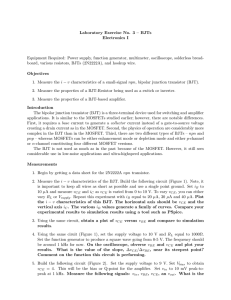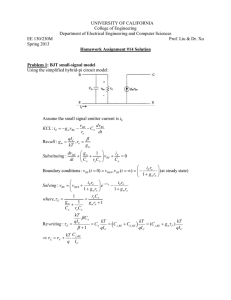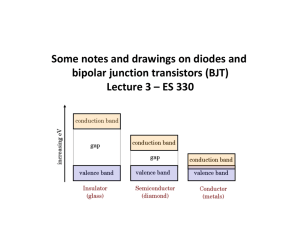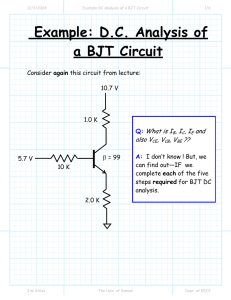303hF09HW4_sol
advertisement
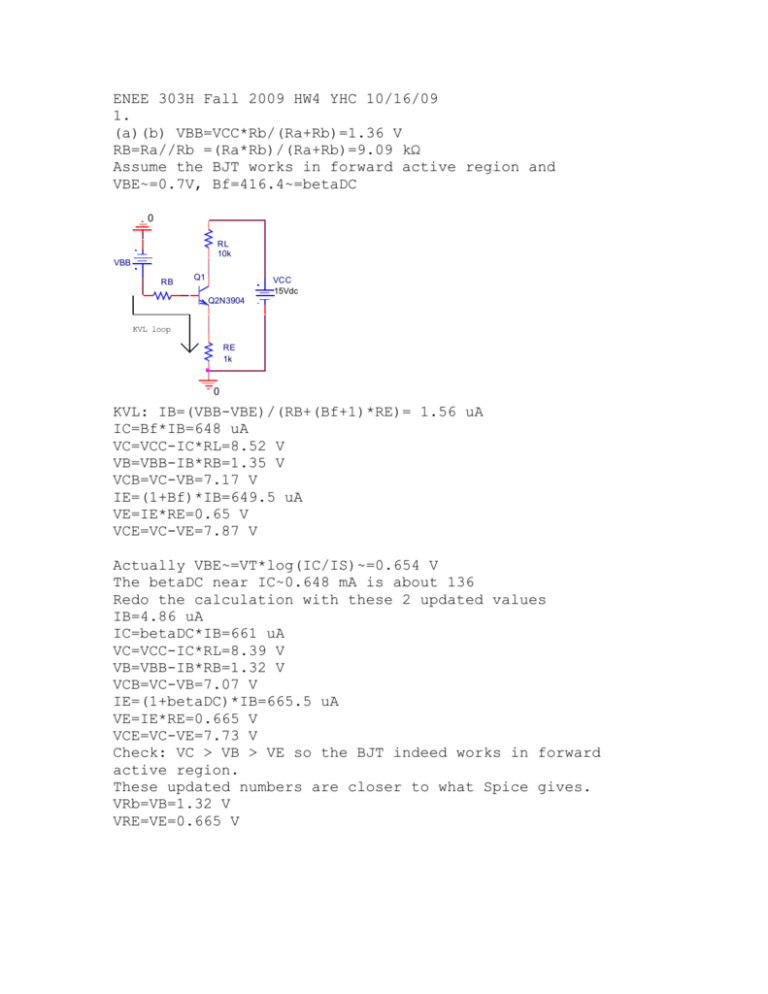
ENEE 303H Fall 2009 HW4 YHC 10/16/09
1.
(a)(b) VBB=VCC*Rb/(Ra+Rb)=1.36 V
RB=Ra//Rb =(Ra*Rb)/(Ra+Rb)=9.09 kΩ
Assume the BJT works in forward active region and
VBE~=0.7V, Bf=416.4~=betaDC
0
RL
10k
VBB
RB
Q1
VCC
15Vdc
Q2N3904
KVL loop
RE
1k
0
KVL: IB=(VBB-VBE)/(RB+(Bf+1)*RE)= 1.56 uA
IC=Bf*IB=648 uA
VC=VCC-IC*RL=8.52 V
VB=VBB-IB*RB=1.35 V
VCB=VC-VB=7.17 V
IE=(1+Bf)*IB=649.5 uA
VE=IE*RE=0.65 V
VCE=VC-VE=7.87 V
Actually VBE~=VT*log(IC/IS)~=0.654 V
The betaDC near IC~0.648 mA is about 136
Redo the calculation with these 2 updated values
IB=4.86 uA
IC=betaDC*IB=661 uA
VC=VCC-IC*RL=8.39 V
VB=VBB-IB*RB=1.32 V
VCB=VC-VB=7.07 V
IE=(1+betaDC)*IB=665.5 uA
VE=IE*RE=0.665 V
VCE=VC-VE=7.73 V
Check: VC > VB > VE so the BJT indeed works in forward
active region.
These updated numbers are closer to what Spice gives.
VRb=VB=1.32 V
VRE=VE=0.665 V
Spice:
NAME
MODEL
IB
IC
VBE
VBC
VCE
BETADC
Q_Q1
Q2N3904
4.86E-06
6.62E-04
6.53E-01
-7.06E+00
7.71E+00
1.36E+02
RE=500 Ω,
IB
IC
VBE
VBC
VCE
BETADC
8.79E-06
1.22E-03
6.70E-01
-1.54E+00
2.21E+00
1.39E+02
RE=2k Ω,
IB
IC
VBE
VBC
VCE
BETADC
2.72E-06
3.49E-04
6.35E-01
-1.02E+01
1.08E+01
1.28E+02
(c)
Ra
100k
RL
10k
PARAMETERS:
Q1
Rpar
VCC
15Vdc
Q2N3904
Rb
10k
RE
{Rpar}
0
1.4mA
1.2mA
1.0mA
0.8mA
0.6mA
0.4mA
0.2mA
0.4K
IC(Q1)
0.6K
0.8K
1.0K
1.2K
Rpar
1.4K
1.6K
1.8K
2.0K
12V
10V
8V
6V
4V
2V
0V
0.4K
VE(Q1)
0.6K
0.8K
VC(Q1)
VC(Q1) - VE(Q1)
1.0K
1.2K
1.4K
1.6K
1.8K
2.0K
Rpar
As RE increases,
1. IC decreases (so does IB, IE, VBE) because the effective
resistance from collector to ground increases.
2. VCE increases (so does VCB). Higher VCE can provide
larger signal swing (before BJT saturates).
3. The voltage drop on RL decreases.
4. IE becomes less sensitive to beta variation
(RE >> RB/(1+beta)).
2.
KP W
(a) I D
2 L
VSG p Vt 0 p
p
=
2
2mA, solve VSGp=4.575 V
This is an approximation value since we have to
take channel length modulation
(the term 1+lambda*VSD) into account.
See the implementation of the current sources in the
following circuit. We can perform a VSGp DC sweep to make
Iin and Iin1 get even closer to 2mA.
VSGP8
4.45Vdc
M4007P
M8
PARAMETERS:
VSGP7
4.36Vdc
Vpar
M5
VDD
15Vdc
M6
V6
{Vpar}
M4007P
M7
M4007N M4007N
{Vpar}
VDS2
M1
M2
M3
M4007N M4007N
M4
M4007N M4007N
0
(b) Saturation condition: VDS VGS Vt
In class it has been shown that VG(M2) is fixed at 4.49
V, so VD(M2)>=4.49-1.3=3.19 V. Similarly, VG(M4)=4.49 V,
VG(M6)= 2*VG(M4)= 8.98 V, so VD(M6)>=8.98-1.3=7.68 V
We improve the output resistance of current mirror at
the expense of using higher VD.
(c)
2.4mA
2.0mA
1.6mA
1.2mA
0.8mA
0.4mA
0A
0V
2V
ID(M2)
ID(M6)
4V
ID(M2) - ID(M6)
IS(M7)
6V
IS(M8)
8V
10V
12V
14V
16V
Vpar
It’s found that for the cascode current mirror the curve is
much flatter (that is, the Early effect is reduced a lot).
The output resistance is amplified by a factor about
gm6*ro6 (p.649 of Sedra/Smith).
With VG(M6) being and VS(M6) not fixed, this allows the
ID(M6) increase caused by VDS increase can be reduced by
VGS decrease.
Because in saturation region ID is more sensitive to VGS,
it has been shown in class that for VD6 = 10 and 12 V, a
small VGS drop (0.04 V) is able to compensate the much
bigger VDS increase (2.04 V).
